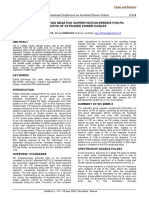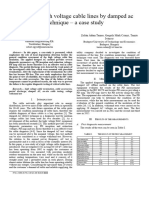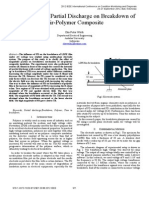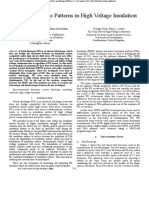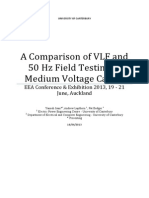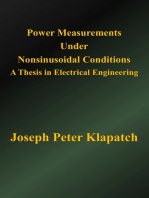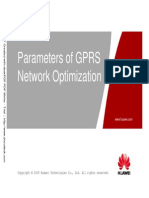Diagnosing The Insulation Condition of Dry Type Transformers Using A Multiple Sensor Partial Discharge Localization Technique
Diagnosing The Insulation Condition of Dry Type Transformers Using A Multiple Sensor Partial Discharge Localization Technique
Uploaded by
hossein_taktaz1Copyright:
Available Formats
Diagnosing The Insulation Condition of Dry Type Transformers Using A Multiple Sensor Partial Discharge Localization Technique
Diagnosing The Insulation Condition of Dry Type Transformers Using A Multiple Sensor Partial Discharge Localization Technique
Uploaded by
hossein_taktaz1Original Title
Copyright
Available Formats
Share this document
Did you find this document useful?
Is this content inappropriate?
Copyright:
Available Formats
Diagnosing The Insulation Condition of Dry Type Transformers Using A Multiple Sensor Partial Discharge Localization Technique
Diagnosing The Insulation Condition of Dry Type Transformers Using A Multiple Sensor Partial Discharge Localization Technique
Uploaded by
hossein_taktaz1Copyright:
Available Formats
Conference Record of the 2002 IEEE lntemational Symposium on Electrical Insulation, Boston, MA USA, April 7-10,2002
Diagnosing the Insulation Condition of Dry Type Transformers using a Multiple Sensor Partial Discharge Localization Technique
Peter Werle, Hossein Borsi, Emst Gockenbach
University of Hannover, Institute of Electric Power Systems Division of High Voltage Engineering, Schering - Institute Callinstrasse 25 A, D-30167 Hannover, Germany
Werle@mbox.si.uni-hannover.de
Abstract: In this contributionan electrical partial discharge (PD) measurement technique for dry type transformer is presented. The method has been tested in the laboratory as well as on a transformer in the test bay using an automated partial discharge evaluation based on the comparison of quasi simultaneously detected PD patterns at different decoupling points. Therefore a multiple sensor system is placed on the surface of the transformer coil, thus PD signals can be measured at various sites along the winding before they are processed and compared. The described technique enables beside a localization of the PD source a determination of the apparent charge, which can be more accurate than conventional narrowband PD measurements via a quadripole in parallel. A discussion of the results leads therefore to a proposal about improvements concerning the calibration for actual PD routine tests on dry type transformers. -
method has been developed, which has been investigated on a test setup in the laboratory as well as on a 400 kVA dry type transformer in the test bay. The results show that beside a localization of the PD origin also a more precise determination of the apparent charge can be possible in comparison to recently applied methods, because the PD signal is decoupled more close to the PD origin, thus damping or distortion as they usually appear during conventional parallel decoupling via a quadripole can not falsify the evaluation. Beyond this background it is discussed if the allowed charge limit of 20 pC at dry type transformers [ 11 can be detected more accurately if another calibration technique than those defined in the standard [2] may lead to more precise results and finally to a better quality assurance.
INTRODUCTION
Since the use of PCB contaminated transformers is restricted and the production of PCB is prohibited many distribution transformers for power levels up to 24 MVA and voltages up to 36 kV have been replaced by dry type transformers usually insulated by epoxy resin. Dry type transformers are due to the absence of self healing effects especially sensitive to partial discharge (PD) phenomena as a result of local field strength extensions in non-homogenous areas of the insulation, which may lead to serious damages over a long time period if they appear once. Therefore PD measurements are recommended with the aim to localize critical points inside the solid insulation, thus a repair of the failure or an improvement in the design of the transformer becomes possible. However, state of the art PD detection techniques, like acoustic or ultrasonic PD localization methods, are often unsuccessful concerning a precise localization of the PD origin. Using these kinds of measurements the PD signals can in general only be acquired inaccurately, due to the high attenuation of the solid insulation, thus a correlation of the gathered signals does not lead to the required results. Furthermore a determination of the apparent charge is not possible by acoustic and ultrasonic measurements, because a calibration can not be performed. This is the reason why usually electrical PD measurements are used during routine tests on dry type transformers after their manufacture, because they allow the determination of the apparent charge but fail on a localization. Therefore a new PD measuring and evaluation
FUNCTIONAL PRINCIPLE AND BASIC MEASUREMENTS
The functional principle of the patented method [3] is quite simple and based on the simultaneous detection of the electromagnetic radiation that is influenced by the PD signal on a multi sensor system, which is mounted on the surface of the transformer coil in such a way that at each winding package one sensor is placed as shown in Figure 1.
PO detmor
Figure 1 - Test setup in the laboratory
A localization of the PD source can be performed by comparing the sensor signals, because the closer a sensor is located to the PD source the higher is its output signal [4].
0-7803-7337-5/02/$17.0002002 EEE.
166
Authorized licensed use limited to: The University of Toronto. Downloaded on August 05,2010 at 07:27:33 UTC from IEEE Xplore. Restrictions apply.
Due to the fact that usually several sensors are necessary the simultaneous detection is replaced by a quasi simultaneous decoupling using a multiplexer to record subsequently the PD activity at the sensor and at a quadripole in parallel to the test object. This procedure reduces the measurement efforts drastically, because otherwise a PD instrument with a lot of input channels would be necessary to log the sensor signals coinstantaneous. Nevertheless, this proceeding does not influence the results significantly, because during the short measurement time the PD activity usually does not change considerably. The signals of the sensors are amplified with a special differential amplifier, which is battery supplied and amplifies the signals against its own reference potential before the signals are transmitted via a fiber optic cable to the PD meter using a frequency range between 100 kHz and 250 kHz. As depicted in Figure 1 at a dry type transformer coil, in whose center a grounded metallic tube has been positioned in order to simulate the transformer core, high voltage has been applied for 120s during a measurement session. Throughout each session PD signals on two channels have been recorded altemately in such a way that each channel has been active for in total 60 s, but a switching of the channels takes place every 10 s. On channel 1 always the pattern from the quadripole has been determined whereas at channel 2 successively all sensors have been connected, thus leading to the results shown in Figure2, where the absolute value of the apparent charge versus the phase angle is displayed for the signals gathered from the sensors and from the quadripole during two different tests. During the tests A (upper two diagrams) and B (lower two maps) it is obvious from the measurements at the quadripoles that the PD activities have been more or less constant during each cycle. However, for test A the signals at the sensors increase sensor by sensor leading to a maximum signal at sensor 7. This indicates that the PD source has to be closest to sensor 7, which indeed has been the case, because for this test a needle plane arrangement inside an epoxy resin block has been connected to the lower clamp of the coil, which is nearby sensor 7. The PD signals generated inside the epoxy resin block close via the coil and the coupling capacitor to ground and causes therefore at the sensors 7 to 1 decreasing signals, due to the damping, distortion and deformation of the PD signals on their propagation through the coil. Regarding the results of test B the signals at the sensors increase from sensor 1 to 4 but remain more or less equal from sensor 4 toy. In this case the PD origin has to be at sensor 4, because the generated PD current at this point flows via the upper coil and the coupling capacitor to ground and causes therefore a voltage drop between the sensors 4 to 1. Because of the fact that almost no PD current flows through the lower part of the coil the sensors 4 to 7 are on the same potential, thus the acquired signals have similar amplitudes. For the described test a grounded needle has been mounted on the surface of the coil close to sensor 4, thus again the PD source has been localized correctly.
Figure 2: - PD measurement results for the test setup
167
Authorized licensed use limited to: The University of Toronto. Downloaded on August 05,2010 at 07:27:33 UTC from IEEE Xplore. Restrictions apply.
PD DETECTION ON A TRANSFORMER IN THE TEST BAY
For the measurements on a 10 kV 1400 V I 400 kVA dry type transformer the setup depicted in Figure 3 has been used, in which only phase W of the transformer has been supplied with a high voltage of approximately 10 kV, whereas all other coils have been grounded, which is in accordance with the actual standard [2]. The high voltage coils of this transformer consist of 12 winding disks, thus in total 12 sensors have been mounted along phase W.
From Figure4 it is obvious that at sensor 12 the correct apparent charge can be measured and that at sensors which are more distant from the PD source the measured apparent charge decreases, what corresponds to the functional principle of the localization. Furthermore it can be seen that at the quadripole only an apparent charge of about 7.3 pC has been measured, although a calibration impulse of 20 pC has been injected, thus only 36.6 % of the original charge has been detected. As mentioned before the reason therefore is that the PD pulse is damped and distorted on the way from its source to the decoupling point as shown in Figure 5, thus the measurement at the quadripole can not assumed to be precise in any case. It has to be pointed out that the closer the PD source is located at the end or respectively lower clamp of the coil the more inaccurate a measurement via the quadripole becomes. As example for the signal deformation an injected calibration pulse of 20 pC as well as its response at the upper clamp of the coil has been recorded simultaneouslyas depicted in Figure 5.
7
f
Figure 3: - PD measurement on a 400 kVA transformer After verifying that the circuit without the specimen is free of discharges a calibration of the sensors has been performed. In contrast to the calibration of the PD detection via quadripole for which a PD pulse has to be injected in parallel to the specimen [2], the calibration impulse has been applied into the lower clamp of phase W, which is close to the sensor 12. Therefore it is possible to calibrate sensor 12, but assuming that all other sensors are uniformly positioned to their according winding package this calibration is valid for all sensors. The apparent charges measured at all sensors and via the quadripole during this calibration are shown in .Figure 4, where a charge of 20pC has been used and the frequency range of the PD analyzer has been adjusted to the span between 40 kHz and 800 kHz.
t
S g 0,
m
150 75
o
-75
- 1 50
25
50
75
100
4
l i m e [ps]
Figure 5: - Voltage-timesignal of injected PD pulse and its response Another conspicuousness concems the fact that the apparent charge measured at the quadripole is about as twice as high as detected on sensor 1. The reason therefore is that the equivalent circuit the PD pulse has to pass through operates in the regarded frequency range of 40 kHz to 800 kHz like a lowpass, which can also be seen in Figure 5, where higher frequencies (see especially steep front of the injected impulse) are much more damped than lower ones (compare with damping of the oscillation). In addition the transfer characteristic of the sensors itself can be approximated by a highpass, thus due to this two opposite tendencies the distorted signal is more accurately detected via the quadripole because of its better transfer properties compared with those of the sensors. After this preparative measurements high voltage has been applied to the coil and the signals at the quadripole and at the sensors have been detected subsequently similar to the measurement described in Figure 2. The results of this test are shown in Figure6, where the absolute values of the phase related apparent charges detected by the sensors are displayed. For the reason that during this investigation the PD activity detected at the quadripole has been again almost uniformly, these signals are not shown. It should only be mentioned that the maximum apparent charge measured at the quadripole has been around 15 pC, which is below the limit defined in the actual standard [l]. However, it becomes obvious from
20
i5
Y
e 9 10
0
0)
5
0
No. of sensor / quadripole (QP)
Figure 4: - Calibration of sensors
168
Authorized licensed use limited to: The University of Toronto. Downloaded on August 05,2010 at 07:27:33 UTC from IEEE Xplore. Restrictions apply.
Figure 6 that there is a slight .increase of the signals gathered from sensor 1 to sensor 9, but between sensor 9 and 10 a significant raise of the apparent charges can be noticed, whereas from sensor 10 to 12 the signals remain nearly constant. This indicates that a PD source has to be close to sensor 10 or respectively in the winding package this sensor is placed on. The maximum apparent charges which have been measured at the sensors 10 to 12 are above 30pC, which is notably above the defined limit, thus this transformer should fail the PD test but it would not if only a measurement via the quadripole would have been performed.
this charge is used as limit adapted to the specimen it can be guaranteed that the criteria of the actual standards are met. Although there is a special note in the annex of the actual standard [2] it would be reasonable if this problem is solved.
CONCLUSION
An improved partial discharge (PD) measurement and evaluation technique has been tested on different setups in the laboratory as well as on a 400 kVA dry type transformer. The PD measurements using the introduced multi sensor system have shown that winding packages in which PD signals appear can be determined efficiently. Furthermore the method allows in general a more precise determination of the apparent charge than conventional parallel decoupling via a quadripole, because the PD signal is decoupled close to the PD origin, thus damping or distortion can not falsify the evaluation. For conventional parallel decoupling methods on dry type transformers a modified calibration method should be considered, for which the calibration impulse is not only injected in parallel to the specimen but also in the end of its winding, thus improving not only the accuracy of the measurement but mainly the intention of quality assurance of PD tests after the production. Otherwise the results show that the larger the part of the coil a PD pulse has to pass the more inaccurate becomes the parallel decoupling technique. As it has been demonstrated this can lead to the problem that a dry type transformer has partial discharges above the allowed limit of 20 pC according to the actual standard, without noticing this dilemma during a conventional PD measurement.
Figure 6: PD measurement results for a 400 kVA transformer
DISCUSSION ACKNOWLEDGMENT
The investigations have shown that with the introduced multi sensor system PD activities can be localized on dry type transformer coils with a simple comparison of the phase related apparent charge diagrams of all sensor signals. The resolution of the localization is at least one winding package, but can be increased by additional techniques if required, although in this contribution this is not pointed out in details. Furthermore at the sensor closest to a PD source the determination of its apparent charge is possible with a higher exactness than with any other known method. Especially compared to the often used decoupling via a quadripole in parallel it has been proven that it might happen that the PD level measured via the quadripole is below the defined limit although it is above the limit at the PD origin, which can be clarified with the sensor system. This situation is not satisfying, thus it is proposed that in case of parallel PD decoupling during PD tests on dry type coils a second calibration is performed if any PD activity is detected during the test. For this calibration an impulse with an apparent charge of 20 pC should be injected into the lower clamp of the coil and the charge at the quadripole, which has been calibrated conventionally in advance, should be measured. If The authors gratefully acknowledge Mr. Franz-Giinter Sebastian for the development of some of the used measurement electronics. Additional acknowledgement is given to Mr. Johannes Jorling for performing some of the presented investigations.
REFERENCES
[I] E C 60726, Amendment No. 1
Dry-Type Power Transformers Intemational standard, 1982, 1986 Am. No. 1
[2]
IEC60270
Partial Discharge Measurements Intemational standard, Ed. 3,2001
[3]
H. Borsi, E. Gcckenbach, P. Werle
V e ~ a h r e nzur Auskopplung und Ortung von Teilentladungen an gieJharzimpragnierten Komponenten wie Spulen und Transformatoren German patent registration, DE 199 62 834,1999
141
P. Werle , V. Wasserberg, H. Borsi, E. Gockenbach A Sensor System .for Partial Disrharge Detection and Localisation on Dry Type Transformers 1 Ith ISH (Intemational Symposium on High Voltage Engineering), Bangalore, India, 2001
169
Authorized licensed use limited to: The University of Toronto. Downloaded on August 05,2010 at 07:27:33 UTC from IEEE Xplore. Restrictions apply.
You might also like
- Models - Semicond.gaas Pin PhotodiodeDocument18 pagesModels - Semicond.gaas Pin PhotodiodebkmmizanNo ratings yet
- Mini FM Transmitter PDFDocument18 pagesMini FM Transmitter PDFrajesh gattem100% (1)
- Service Manual l62Document34 pagesService Manual l62Roberto Sánchez100% (1)
- Experiment 8 Series and Parallel Circuits Physics LabDocument7 pagesExperiment 8 Series and Parallel Circuits Physics Labvada_soNo ratings yet
- Instruction To IEC 60270Document4 pagesInstruction To IEC 60270vtechelectric33% (3)
- Cap SensorDocument3 pagesCap SensorSudip ChakrabortyNo ratings yet
- Partial Discharge Measurement and Evaluation Techniques For TransformersDocument4 pagesPartial Discharge Measurement and Evaluation Techniques For TransformersmvvnrajeshNo ratings yet
- Partial Discharge Measurement and Monitoring On High Voltage XLPE CablesDocument14 pagesPartial Discharge Measurement and Monitoring On High Voltage XLPE CableskarakoukasNo ratings yet
- 8 International Conference On Insulated Power CablesDocument6 pages8 International Conference On Insulated Power CablesHafiziAhmadNo ratings yet
- Paper 441Document10 pagesPaper 441sunilNo ratings yet
- Ish2017 269Document6 pagesIsh2017 269sunnysenatorNo ratings yet
- An Introduction To On-Line Partial Discharge (PD) Testing of Medium Voltage (MV) SwitchgearDocument13 pagesAn Introduction To On-Line Partial Discharge (PD) Testing of Medium Voltage (MV) SwitchgearHoang Thanh VanNo ratings yet
- A2-205 - 2018 Localization of Partial Discharge Sources in Transformers by Analysis of Signals in Time - and Frequency-Domain PDFDocument18 pagesA2-205 - 2018 Localization of Partial Discharge Sources in Transformers by Analysis of Signals in Time - and Frequency-Domain PDFNamLeNo ratings yet
- Egyed 2016Document4 pagesEgyed 2016fernandoquecaNo ratings yet
- Influence of Partial Discharge On Breakdown of Air-Polymer CompositeDocument4 pagesInfluence of Partial Discharge On Breakdown of Air-Polymer CompositeEka WaldiNo ratings yet
- Online Partial Discharge DetectionDocument5 pagesOnline Partial Discharge Detectionbpd21No ratings yet
- On-Line Calibration of Partial Discharge Monitoring For Power Cable by HFCT MethodDocument5 pagesOn-Line Calibration of Partial Discharge Monitoring For Power Cable by HFCT MethodClaysius DewanataNo ratings yet
- B1.13 IBA M ZerrerDocument5 pagesB1.13 IBA M ZerrerVictor AgueroNo ratings yet
- Recent Experiences With Ac Hipot & PD Commissioning Testing of Xlpe Cable Systems Rated 69Kv and Above Mark. Fenger, Mark Credland, Howard Sedding Kinectrics Inc CanadaDocument8 pagesRecent Experiences With Ac Hipot & PD Commissioning Testing of Xlpe Cable Systems Rated 69Kv and Above Mark. Fenger, Mark Credland, Howard Sedding Kinectrics Inc CanadaricNo ratings yet
- IMCORP TDR ProcedureDocument9 pagesIMCORP TDR ProcedurelatifNo ratings yet
- A Guide For Partial Discharge Measurements On Medium Voltage (MV) and High Voltage (HV) ApparatusDocument7 pagesA Guide For Partial Discharge Measurements On Medium Voltage (MV) and High Voltage (HV) ApparatusAmanda MeloNo ratings yet
- A Versatile System For PD Diagnostics: L. V. Badicu, W. Koltunowicz, O. KrauseDocument4 pagesA Versatile System For PD Diagnostics: L. V. Badicu, W. Koltunowicz, O. KrauseNguyen Vu Nhat HaNo ratings yet
- Experimental Study of Partial Discharge Pulses Propagation in Stator Winding of Hydro GeneratorDocument5 pagesExperimental Study of Partial Discharge Pulses Propagation in Stator Winding of Hydro Generatormahdi77noroNo ratings yet
- On-Site PD Diagnostics, FRA and Moisture Measurement For Power TransformersDocument6 pagesOn-Site PD Diagnostics, FRA and Moisture Measurement For Power Transformersalireza shaNo ratings yet
- Partial Discharge Patterns in High Voltage InsulationDocument7 pagesPartial Discharge Patterns in High Voltage Insulationfery zenNo ratings yet
- On-Line Versus Off-Line - Practical Aspects of Sensitive On-Site PD Detection in Power Cables PDFDocument16 pagesOn-Line Versus Off-Line - Practical Aspects of Sensitive On-Site PD Detection in Power Cables PDFSellappan MuthusamyNo ratings yet
- Zulu James Lab 1 4157Document7 pagesZulu James Lab 1 4157James Jimmy JahNo ratings yet
- 29 - Kim PD Measure and Monitoring On HV Cables PDFDocument4 pages29 - Kim PD Measure and Monitoring On HV Cables PDFbcqbaoNo ratings yet
- The Use of Absolute LimitsDocument11 pagesThe Use of Absolute LimitsMUSTAKUL ALAM BARLASKARNo ratings yet
- Setup and Preliminary Results of A Pilot On-Line Cable PD Monitoring System On An 11 KV Switchboard Using Capacitive CouplersDocument4 pagesSetup and Preliminary Results of A Pilot On-Line Cable PD Monitoring System On An 11 KV Switchboard Using Capacitive Couplerssnigdha_musiclover0% (1)
- Partial Discharge TestingDocument6 pagesPartial Discharge TestinggvamovicNo ratings yet
- Study On Different Techniques of Partial Discharge (PD) Detection in Power Transformers Winding: Simulation Between Paper and EPOXY Resin Using UHF MethodDocument5 pagesStudy On Different Techniques of Partial Discharge (PD) Detection in Power Transformers Winding: Simulation Between Paper and EPOXY Resin Using UHF MethodashwiniNo ratings yet
- Pract Exp - PDMeas On Cable Access - IMPDocument4 pagesPract Exp - PDMeas On Cable Access - IMPrasool waniNo ratings yet
- PD Measurement of Open Air HV Cable Termination at The Ground Plate Without Coupling CapacitorDocument4 pagesPD Measurement of Open Air HV Cable Termination at The Ground Plate Without Coupling CapacitorRahul YadavNo ratings yet
- MS-Partial Discharge MeasurementDocument9 pagesMS-Partial Discharge MeasurementSumitha BaskarNo ratings yet
- Partial Discharge As A Quality Assurance Test For Motor Stator WindingsDocument6 pagesPartial Discharge As A Quality Assurance Test For Motor Stator WindingsKUNALJAYNo ratings yet
- PD Waveform in Three-Phase Sf6 Gis From Single and Multi Source PD at Various Positions-Edit2Document5 pagesPD Waveform in Three-Phase Sf6 Gis From Single and Multi Source PD at Various Positions-Edit2Fari PratomosiwiNo ratings yet
- EC2405 - Microwave Experiments PDFDocument34 pagesEC2405 - Microwave Experiments PDF9985237595100% (7)
- 2013_Wild_EIC_Practical_aspects_of_PD_localization..Document5 pages2013_Wild_EIC_Practical_aspects_of_PD_localization..TXEMANo ratings yet
- Patrones PDDocument4 pagesPatrones PDJuan LopezNo ratings yet
- Power Cable On-Line Diagnosis Partial Discharges Ultra Wide Techniques Using BandDocument5 pagesPower Cable On-Line Diagnosis Partial Discharges Ultra Wide Techniques Using BandDebojyoti MukherjeeNo ratings yet
- Calibracion de HFCT en PCDocument5 pagesCalibracion de HFCT en PCGerardoNo ratings yet
- Partial Discharges in Typical Defects of Power Cable Systems at Variable Test Voltage Frequency - Fundamental and Practical ConsiderationsDocument5 pagesPartial Discharges in Typical Defects of Power Cable Systems at Variable Test Voltage Frequency - Fundamental and Practical Considerationsbharat_22nandulaNo ratings yet
- S4-05-PD Measurement On Power CablesDocument8 pagesS4-05-PD Measurement On Power CablesRAVINDERNo ratings yet
- RF Lab 2 Short (Final)Document7 pagesRF Lab 2 Short (Final)Lee Boon YeeNo ratings yet
- Measurement Technology of Grounding Capacitance of Distribution Network Based On The Graded Adjustment of Grounding Transformer WindingDocument7 pagesMeasurement Technology of Grounding Capacitance of Distribution Network Based On The Graded Adjustment of Grounding Transformer Windingalex696No ratings yet
- VLF 50-0-1Hz ComparisionDocument10 pagesVLF 50-0-1Hz ComparisionnrasoolNo ratings yet
- SP_201901_PQ-under-the-microscope_ENDocument8 pagesSP_201901_PQ-under-the-microscope_ENđức hoàngNo ratings yet
- PD 6 Online PD Monitoring Power CablesDocument21 pagesPD 6 Online PD Monitoring Power CablesAbhishek GuptaNo ratings yet
- PD Testing and Monitoring of HV XLPE Cable Systems ENUDocument7 pagesPD Testing and Monitoring of HV XLPE Cable Systems ENUAnh Tuan NguyenNo ratings yet
- Application of The Integrated AE and HFCT Sensors For Online Dry-Type Transformer Partial Discharge Monitoring. Case StudyDocument7 pagesApplication of The Integrated AE and HFCT Sensors For Online Dry-Type Transformer Partial Discharge Monitoring. Case Studyduong nguyenNo ratings yet
- PD Measurements On HV JointsDocument4 pagesPD Measurements On HV Jointsจีรศักดิ์ คงบุรีNo ratings yet
- 2010 CIGRE A2 - 211 TrafoDocument9 pages2010 CIGRE A2 - 211 TrafoDante FilhoNo ratings yet
- Partial Discharge in Gas Insulated Sub-StationsDocument12 pagesPartial Discharge in Gas Insulated Sub-StationsAishwaryaNo ratings yet
- PhysRevB 79 155441Document6 pagesPhysRevB 79 155441nitro_DNo ratings yet
- Partial Discharge Patterns in High Voltage InsulationDocument6 pagesPartial Discharge Patterns in High Voltage InsulationAmin SameipoorNo ratings yet
- N. Bacalso Avenue, Cebu City: Cebu Institute of Technology - UniversityDocument15 pagesN. Bacalso Avenue, Cebu City: Cebu Institute of Technology - UniversityTreyes RobertNo ratings yet
- CIGRE - Paris-Application of Partial Discharge Diagnostic Technique On High Voltage Cable Sealing EndsDocument9 pagesCIGRE - Paris-Application of Partial Discharge Diagnostic Technique On High Voltage Cable Sealing EndsKarthik SriramakavachamNo ratings yet
- Maintenance and Dissemination of The Magnetic Field Unit at PTBDocument4 pagesMaintenance and Dissemination of The Magnetic Field Unit at PTBafmm_metrologiaNo ratings yet
- Power Measurements Under Nonsinusoidal Conditions : A Thesis in Electrical EngineeringFrom EverandPower Measurements Under Nonsinusoidal Conditions : A Thesis in Electrical EngineeringNo ratings yet
- Stem: Science, Technology, Engineering and Maths Principles Teachers Pack V11From EverandStem: Science, Technology, Engineering and Maths Principles Teachers Pack V11No ratings yet
- STEM: Science, Technology, Engineering and Maths Principles Teachers Pack V10From EverandSTEM: Science, Technology, Engineering and Maths Principles Teachers Pack V10No ratings yet
- Automatic Car Parking SystemDocument2 pagesAutomatic Car Parking SystemCrispNo ratings yet
- WEG CFW 11 plc11 Modulo Com Funcoes de CLP Guia de Instalacao Portugues BR PDFDocument24 pagesWEG CFW 11 plc11 Modulo Com Funcoes de CLP Guia de Instalacao Portugues BR PDFLeandro MartirNo ratings yet
- Dap Audio DCP 24 MANUAL GB - V1Document36 pagesDap Audio DCP 24 MANUAL GB - V1Ioannis PerperisNo ratings yet
- Optical Fibre FormulasDocument2 pagesOptical Fibre FormulasImam Tri BaskoroNo ratings yet
- Brochure UPS DPH-50-300 500 600kVA enDocument8 pagesBrochure UPS DPH-50-300 500 600kVA endragonksbNo ratings yet
- 39 22EC10057 PrasitDocument4 pages39 22EC10057 PrasitSutanu SenNo ratings yet
- ATX - Wikipedia, The Free EncyclopediaDocument13 pagesATX - Wikipedia, The Free Encyclopediakldeep3221No ratings yet
- The Common-Emitter AmplifierDocument16 pagesThe Common-Emitter AmplifierJom Agullana100% (1)
- H-Parameters and Single Stage Amplifier AnalysisDocument14 pagesH-Parameters and Single Stage Amplifier AnalysisMrs. P. Ganga BhavaniNo ratings yet
- Audio/Video Connectivity Solutions For Spartan-3E FPGAsDocument76 pagesAudio/Video Connectivity Solutions For Spartan-3E FPGAsahimpliNo ratings yet
- Huawei PS-Parameters of GPRS Network OptimizationDocument57 pagesHuawei PS-Parameters of GPRS Network OptimizationVito WahyudiNo ratings yet
- Schneider Electric PLC-Modicon-M221 TM221CE16RDocument18 pagesSchneider Electric PLC-Modicon-M221 TM221CE16Ryulisaaini75No ratings yet
- Pressure Switch: Up To 2 Switching Outputs Analogue OutputDocument4 pagesPressure Switch: Up To 2 Switching Outputs Analogue OutputОстап ФеренсовичNo ratings yet
- Electronic Principles-945-946Document2 pagesElectronic Principles-945-946Cak HanepNo ratings yet
- محمد الحبيشي خاصDocument79 pagesمحمد الحبيشي خاصmsaqer53No ratings yet
- AUTOSAR SWS WirelessEthernetTransceiverDriverDocument53 pagesAUTOSAR SWS WirelessEthernetTransceiverDriverStefan RuscanuNo ratings yet
- First CCTV QuotationDocument3 pagesFirst CCTV Quotationsyamprasad100% (1)
- Mes9 - XXXPX: Electrical SpecificationsDocument3 pagesMes9 - XXXPX: Electrical SpecificationsRezaadityamuhaNo ratings yet
- Paper FinfetbasedotaDocument5 pagesPaper FinfetbasedotaJaganNo ratings yet
- Command Set V2.4Document56 pagesCommand Set V2.4director tecnicoNo ratings yet
- Tutorial DVD - To - Avi (Avidemux) - 1584054360621 PDFDocument4 pagesTutorial DVD - To - Avi (Avidemux) - 1584054360621 PDFSasa MiljkovicNo ratings yet
- H-Tutorial Impedance MatchingDocument24 pagesH-Tutorial Impedance Matchingngt881100% (1)
- Lesson 11Document14 pagesLesson 11Ronald CalingganganNo ratings yet
- TM 11 5865 229 12Document105 pagesTM 11 5865 229 12izking2007No ratings yet
- Design of A Single Band Microstrip Patch Antenna For 5G ApplicationsDocument4 pagesDesign of A Single Band Microstrip Patch Antenna For 5G ApplicationsOwaisKhanNo ratings yet
- MotherboardsDocument29 pagesMotherboardslynnlahlohNo ratings yet
- Crystal Oscillator Circuits Robert J MatthysDocument252 pagesCrystal Oscillator Circuits Robert J Matthyssuper_lativoNo ratings yet








